|
There is nothing magic about free-energy and by “free-energy” I mean something which produces output energy without the need for using a fuel which you have to buy. The 3-Kilowatt Earth Battery This battery does not need to be charged. Earth batteries are well known. They are pairs of electrodes buried in the ground. Electricity can be drawn from them, but they are generally of little interest as the power levels are not great. However, in his patent of 1893, Michael Emme, a Frenchman living in America determined how to get very serious levels of power from an earth battery of his design. In this particular unit which he describes in his US 495,582 patent, he gets 56 amps at just under 54 volts, which is three kilowatts or 4 HP. At that early date, there was generally, not much need for electricity, but Michael states that by selecting the number and connection method of the individual components, any desired voltage and/or current supply can be had. This, of course, is a simple system which involves no electronics. Please bear in mind that some forms of construction utilise strong acids and careless handling of strong acid can result in skin and other damage. Protective clothing should be used when handling acids and an alkali should be ready for immediate use if careless handling causes splashes. Summarising his patent, Michael says: My invention relates to chemical generators of electricity where a prepared body of earth is the support and excitation medium for the electrodes or elements. Any number of elements can be assembled in the same piece of ground and connected in a chain or series of chains in order to produce the desired voltage and/or amperage. I find that several straight chains of elements can function separately provided that the gap between the chains is much greater than the gap between the elements which form the chain. Being quite separate, those chains can be connected in series to increase the voltage, or in parallel to increase the available current. It is necessary to prepare the soil in the ground in the immediate area around the electrodes which form each element in the chain.  Fig.1 shows five elements connected in a chain. This view is from above with the rectangles indicating holes in the ground where each hole contains seven separate pairs of electrodes. 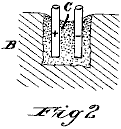 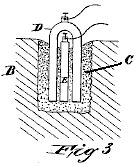 Fig.2 and Fig.3 show how individual electrodes are inserted into the prepared soil “C” which is surrounded by untreated ground “B”. Electrode “D” is made of iron and “E” is made of carbon.  Fig.4 shows how wedge-shaped electrodes can be used as an alternative construction. The advantage is that it is easier to pull a tapering electrode out of the ground. 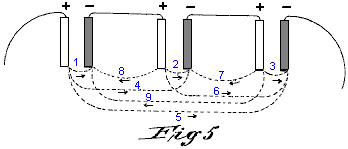 Fig.5 shows the internal current flow circuits which operate when a chain of elements is used. The arrows indicate the direction of current flow. 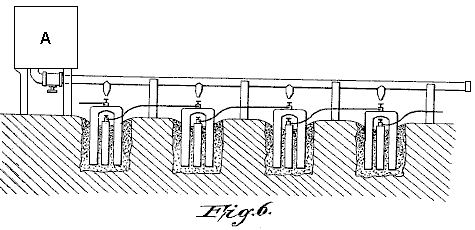 Fig.6 shows a convenient method for periodically moistening the prepared soil areas. Soil of any type can be adapted for use with an electrical generator of this kind by saturating the soil immediately surrounding each pair of electrodes with a suitable solution which is rich in oxygen, chlorine, bromine, iodine or fluorine, or with a solution of a salt of an alkali. For the electrodes, I prefer to use soft iron for the positive electrode and hard pressed coke carbon for the negative electrode. The positive electrode is preferably a U-shaped bar of iron which has a circular cross-section. The two limbs of the U straddle the rod of carbon. Cast iron can be used but it gives a lower voltage, presumably due to the carbon and other impurities in it. Magnesium gives excellent results, producing 2.25 volts per electrode pair where carbon is the negative electrode.  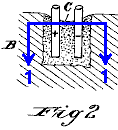 In implementing my invention, I level a piece of ground of sufficient area to contain the generating chain or chains. For instance, for three hundred positive elements each twenty inches (500 mm) long and two inches (50 mm) in diameter, bent as shown in Fig.3, the length of the piece of ground should be about 107 feet (32 metres) and 3 feet (1 metre) wide. I dig 43 holes at a distance of 30 inches (735 mm) apart (centre to centre) in a line. Each hole is 10 inches (250 mm) wide and 30 inches (750 mm) long and deep enough to contain the seven pairs of electrodes. The loose soil dug from the holes is mixed with the chosen salt or acid in order to make the generator active. For instance, if the ground is a vegetable mould, then commercial concentrated nitric acid should be added in sufficient quantity to saturate the soil, and manganese peroxide or pyrolusite should be mixed with the mass. If the soil has a sandy character, then hydrochloric acid or sodium carbonate (“washing soda”) or potash can be used. If the coil is a clay, then hydrochloric or sulphuric acid and sodium chloride may be used, the salt being dissolved in water and poured into the hole before the acid is mingled with the soil. The bottom of the hole is moistened with water and the prepared soil mixed with water to the consistency of a thick paste is then placed in the hole, surrounding the electrodes. The 43 groups of electrodes when wired in series as shown in Fig.1, will yield 53.85 volts and 56 amps, developing a total of 3015 watts.  By increasing the number of cells, the capacity of the generator may be correspondingly increased to any desired power output. The prepared body of soil should be periodically moistened, preferably with the acid with which it was treated when first prepared for action. In a generator intended for continuous use, I prefer to provide a reservoir as shown as “A” in Fig.6, and run a pipe made of a material which is not attacked by the acid, along the chain of elements, with a nozzle over each element so that they all can be moistened very easily. Any accumulation of oxides or other products of the reaction between the prepared soil and the electrodes may be removed by raising the positive electrode and then forcing it back into place again. The carbon electrode can be cleansed by simply turning it without lifting it from its place. I find that the period of use of the generator during which no addition of salt or acid is needed, increases with the period of use. For example, during the first day of use, the acid or salt should be added after 10 hours of use, after which it will yield 26 hours of service, and then after another moistening it will operate for 48 hours, and so on, progressively increasing in duration between being moistened. This generator operates very consistently and reliably. Nowadays, we find mains voltage alternating current to be the most convenient to use. For a system like this, we would be inclined to use an ordinary inverter which runs on twelve volts or twenty-four volts. However, it needs to be remembered that the working input current is high and so, the wire used to carry that current needs to be thick. At 12V, each kilowatt is a current of at least 84 amps. At 24V that current is 42 amps (the inverter itself is more expensive as fewer are bought). Considerable household usage can be had from a 1500 watt inverter. The soft iron / carbon construction described by Michael Emme produces 54V from 43 sets of electrodes, indicating around 1.25V per set at high current draw. It seems reasonably likely that ten or eleven sets of electrodes would give around 12V at high current and three of those chains connected in parallel should be able to power a 1500 watt 12V inverter continuously at extremely low running cost. Patrick Kelly http://www.free-energy-info.com http://www.free-energy-devices.com http://www.free-energy-info.tuks.nl |